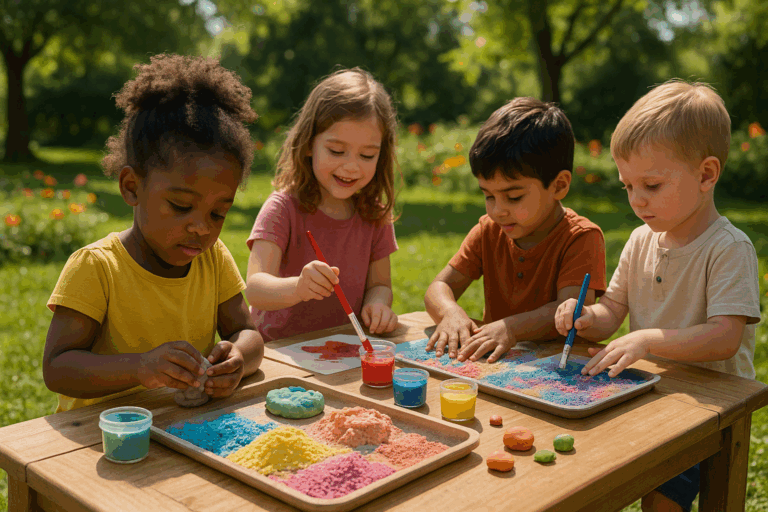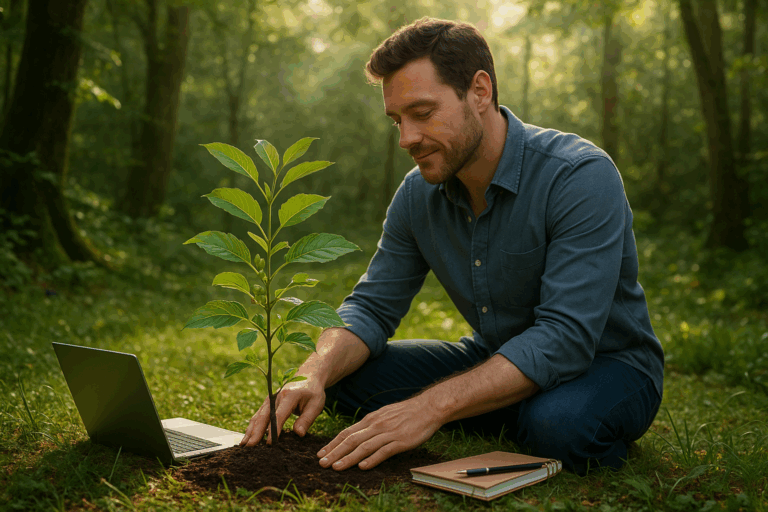The underlying philosophy is as beautiful as it is simple: to offer children a world of fun while simultaneously nurturing their sense of responsibility towards the environment. 🌳 This blog post aims to guide parents and caregivers on the path to green and clean playtime, showcasing a selection of eco-friendly baby toys that don’t compromise on enjoyment or developmental stimulation.
Before we delve into the heart of the matter, let’s take a brief detour to understand the ‘why’ behind the significance of eco-friendly toys. The essence lies in the toys’ ability to create a harmonious blend of ethical sourcing, safe manufacturing, and educational engagement, all wrapped up in a package of endless fun. They provide an early introduction to environmental consciousness, subtly teaching our little ones about the importance of sustainable living.
We will be discussing a variety of eco-friendly toys, including their materials, manufacturing process, and the developmental benefits they offer. Be it toys made from recycled milk jugs or organic cotton stuffed animals, this green revolution in the playroom brings forth a multitude of options. Each toy, in its unique way, fosters creativity, promotes cognitive development, and, above all, respects Mother Earth. 🌍
So, why the emphasis on ‘Green and Clean’?
As we navigate the 21st century, the call for a sustainable future grows louder. And rightfully so. After all, our actions today determine the world our children will inherit. It’s only fitting, then, that we include them in our sustainability journey right from their early years. By introducing them to eco-friendly toys, we instill in them a love for the planet that they’ll carry well into adulthood. We’ll delve deeper into this aspect in a later section of the post.
Are ‘Eco-friendly’ and ‘Sustainable’ synonymous?
While these terms are often used interchangeably, they subtly differ in their implications. A toy can be eco-friendly by being biodegradable or made from recycled materials, but it is only sustainable if its entire life cycle — from sourcing to disposal — leaves a minimal ecological footprint. We’ll be addressing this distinction and its significance in more detail further on.
So, whether you’re a parent striving to provide your child with an environment-friendly upbringing, or a caregiver passionate about sustainable solutions, this comprehensive guide on eco-friendly baby toys is tailor-made for you. We’ll explore the multifaceted world of green toys, taking into account the educational value, safety considerations, and, of course, the fun factor. 🧸
Stay tuned, and let’s embark on this journey towards sustainable playtime bliss!
Discover the Benefits of Eco-Friendly Baby Toys
As a parent, you’re always looking for the best for your child. You want to provide them with experiences that not only entertain but also educate, and you want to do so in a way that’s safe and sustainable. This is where eco-friendly baby toys come in. They’re designed with your child’s well-being in mind, offering a safe, educational, and environmentally friendly alternative to traditional plastic toys. In this article, we’ll delve into the world of green playtime, exploring the benefits of these toys, how to choose the right ones for your little one, and some of the best brands on the market. 🌿
Eco-friendly toys are not just a trend; they represent a commitment to sustainability and the preservation of our planet for future generations. They are made from sustainable materials, like wood, organic cotton, or recycled plastics, and are designed to be durable and long-lasting, reducing waste. Moreover, these toys are often produced in fair trade conditions, supporting local communities and artisans. Not only are you providing your child with a fun and educational tool, but you’re also making a positive impact on the environment and society.
Health-wise, eco-friendly toys also have an edge. Unlike traditional toys that can contain harmful chemicals such as lead, phthalates, or BPA, green toys are usually made with non-toxic finishes and dyes. This is particularly important for babies and toddlers who often explore the world with their mouths. The peace of mind that comes from knowing your child’s toys are safe is priceless.
A Guide to Choosing Eco-Friendly Baby Toys
Choosing the right eco-friendly toy for your baby involves more than just selecting a toy made from green materials. You also need to consider the educational value of the toy, its durability, and of course, whether your baby will enjoy playing with it. Here are some key factors to consider when shopping for sustainable playtime bliss:
Age Appropriateness: Ensure the toy is suitable for your baby’s age and developmental stage. This information is usually provided by the manufacturer. Toys that are too advanced may frustrate your baby, while those that are too simple may not engage their interest.
Educational Value: The best toys are those that stimulate your baby’s senses and encourage them to learn and explore. Look for toys that promote motor skills, cognitive development, or social interaction.
Safety: Safety should always be a priority when buying toys. Check for small parts that could pose a choking hazard, sharp edges, or any loose components. Also, ensure the toy is non-toxic and free from harmful chemicals.
Lastly, consider the toy’s longevity. Will it hold your baby’s interest as they grow? Is it durable enough to withstand rough play? A high-quality, engaging toy is an investment that will keep your little one entertained and learning for years to come.
Top Brands for Eco-Friendly Baby Toys
Now that we’ve covered the benefits of eco-friendly toys and how to choose them, let’s look at some of the top brands in the field. These brands are committed to sustainability and quality, offering a wide range of toys that are safe, fun, and educational.
Brand
Specialty
Material
Plan Toys
Sustainable wooden toys
Chemical-free rubberwood
Green Toys
Recycled plastic toys
Recycled milk jugs
Hape
Innovative playthings
Bamboo and other sustainable materials
For more details on these brands and their offerings, watch the video “Best Eco-Friendly Toy Brands for Babies and Toddlers” by The Green Parenting Guide on YouTube.
Embracing a Green Playtime
Introducing eco-friendly toys to your baby’s playtime is more than just a responsible choice; it’s an investment in their health, development, and the world they’ll inherit. These toys offer a wealth of benefits, from safety and durability to educational value, and they do so without compromising on fun. So, as you embark on your journey towards sustainable parenting, remember to consider green toys for your little one’s playtime. They are a step towards a healthier, happier, and more sustainable world. 🌎
Remember, green playtime isn’t just about the toys; it’s also about how you play. Encourage your child to appreciate and care for their toys, instilling in them values of sustainability and respect for the environment. After all, our actions today will shape the world our children live in tomorrow.
ConclusionIn conclusion, after a meticulous journey through the intricacies of software engineering, we have come to understand its dynamic nature and immense significance in our digital age. We’ve delved into its crucial aspects, including the principles of software engineering, development methodologies, programming languages, software testing, and project management strategies, among others.
In the grand scheme of the digital era, software engineering is no less than a cornerstone. It is the engine that drives the digital solutions catering to a multitude of industries, services, and sectors. As we have seen throughout this discourse, the principles of software engineering form the bedrock of this domain. They provide the scaffolding that holds together the entire structure of software development.
The discussion on development methodologies elucidated the practical aspects of software engineering. Agile, waterfall, and DevOps methodologies not only represent different approaches towards software development but also different philosophies. Understanding the nuances of these methodologies is key to building robust, reliable, and efficient software products.
The exploration of programming languages shed light on the diverse landscape of coding and its evolution. As we learned, every programming language comes with its own set of strengths, weaknesses, and use-cases, making the choice of language a significant decision in the software development process.
Next, we touched upon the vital aspect of software testing. It’s here that we affirmed the quality of the software product, ensuring it meets the required standards and specifications. From unit testing to integration testing, from functional to non-functional testing, every phase of this process plays a critical role in assuring the reliability and performance of the software.
Finally, we examined the role of project management in software engineering. With a spotlight on strategies and tools, we understood how effective project management not only streamlines the development process but also enhances the productivity and collaboration within the team.
As we wrap up this deep dive into the realm of software engineering, it’s important to emphasize that this field is an ever-evolving landscape. Continuous learning, staying updated with latest trends, and adapting to new technologies are imperative for anyone aspiring to excel in this domain.
I encourage you to share your thoughts, insights, and experiences in the comments section below. Let’s create a thriving community of software engineering enthusiasts who learn from and inspire each other. Please feel free to share this article with others who might find it valuable.
Looking to delve deeper into the subject? Here are some useful resources:
– IEEE Software: A peer-reviewed technical magazine, it covers all aspects of software engineering.
– ACM Transactions on Software Engineering and Methodology: A highly respected resource that provides in-depth articles on the latest research in software engineering.
– Software Engineering Institute (SEI): A U.S.-based research and development center that provides software engineering resources.
This journey through the fascinating world of software engineering has been insightful, illuminating, and exciting 🚀. Let’s keep the momentum going and continue to explore, learn, and grow 🌱. With the power of knowledge, innovation, and collaboration, there’s no limit to what we can achieve in this dynamic field! 💪
Software Engineering, Development Methodologies, Programming Languages, Software Testing, Project Management
References:
IEEE Software
ACM Transactions on Software Engineering and Methodology
Software Engineering Institute (SEI)



